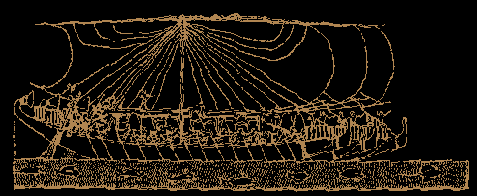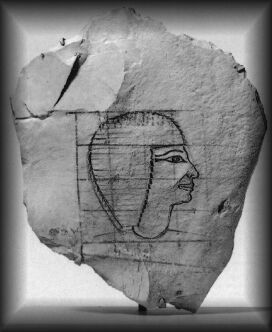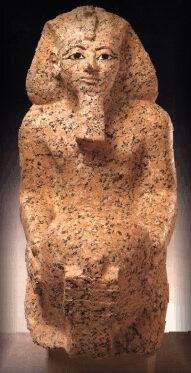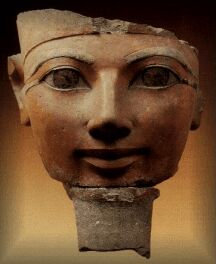

Born in the 15th century BC, Hatshepsut, daughter of Tuthmose I and Aahmes, both of royal lineage, was the favorite of their three children. When her two brothers died, she was in the unique position to gain the throne upon the death of her father. To have a female pharaoh was unprecedented, and probably most definitely unheard of as well. When Tuthmose I passed away, his son by the commoner Moutnofrit, Tuthmose II, technically ascended the throne. For the few years of his reign, however, Hatshepsut seems to have held the reins. From markings on his mummy, archaeologists believe Tuthmose II had a skin disease, and he died after ruling only three or four years. Hatshepsut, his half sister and wife, had produced no offspring with him (her daughter Nefrure was most likely the daughter of her lover Senmut), although he had sired a son through the commoner Isis. This son, Tuthmose III, was in line for the throne, but due to his age Hatshepsut was allowed to reign as queen dowager.

Hatshepsut was not one to sit back and wait for her nephew to age enough to take her place. As a favorite daughter of a popular pharaoh, and as a charismatic and beautiful lady in her own right, she was able to command enough of a following to actually take control as pharaoh. She ruled for about 15 years, until her death in 1458 BC, and left behind more monuments and works of art than any Egyptian queen to come.

Hatshepsut, as a female, had many obstacles to overcome. There was always a threat of revolt, especially as her bitter nephew came of age. Using propaganda and keen political skills, she deftly jumped each hurdle she faced. To quell the fears of her people, she became a "king" in all statuary and relief during her reign. She even dressed in the traditional garb of male rulers: the shendyt kilt, the nemes headdress with its uraeus and khat headcloth, and the false beard. Although there were no wars during her reign, she proved her sovereignty by ordering expeditions to the land of Punt, in present-day Somalia, in search of the ivory, animals, spices, gold and aromatic trees that Egyptians coveted. These expeditions are well documented in the hieroglyphic inscriptions on the walls of her temple. With these inscriptions are included incised representations of the journey, including humorous images of the Puntites and their queen, at whom the Egyptians no doubt looked while restraining a giggle; the queen has folds of fat hanging over her knees and elbows, her back is crooked and she has an aquiline nose. To the short, thin Egyptian she was probably quite a sight. Hatshepsut, in a final bid to be recognized as a legitimate queen, constructed a fabulous temple in the Valley of the Kings, of all places, by a tall plateau at Deir-el-Bahri, across the Nile from Thebes.
Hatshepsut was a master politician, and an elegant stateswoman with enough charisma to keep control of an entire country for twenty years. Her charisma and experience could carry her only so far, however. She used two devices to ensure the legitimacy of her position. The first was to emphasize not only her relationship to Tuthmose I, but her favor from that popular ruler. She claimed to have been handpicked by her father, above her two brothers and her half-brother. In her temple are written the words of Khnum, the divine potter who sculpted the forms of the gods:
| I will make you to be the first of all living creatures, you will rise as king of Upper and of Lower Egypt, as your father Amon, who loves you, did ordain. |
This assertion has validity, as other texts indicate. Her second conceit was more doubtful, however: she claims a direct divine lineage. As in the previous passage, she claims Amon is her father. On the walls of her tomb is inscribed a story detailing the night the Theban god Amon-Re approached Aahmes in the form of Tuthmose I.
 |
Amon took the form of the noble King Tuthmose and found the queen sleeping in her room. When the pleasant odours that proceeded from him announced his presence she woke. he gave her his heart and showed himself in his godlike splendour. When he approached the queen she wept for joy at his strength and beauty and he gave her his love... |
These propaganda worked well to cement Hatshepsut's position. But as Tuthmose III grew, her sovereignty grew tenuous. He not only resented his lack of authority, but no doubt harbored only ill will towards his step-mother's consort Senmut. Senmut originally intended to be buried in the tomb he designed for Hatshepsut, but was actually buried nearby in his own tomb. Not long after his death, however, his sarcophagus was completely destroyed. The hard stone that had been carved for his funerary coffin was found in over 1,200 pieces. His mummy was never found. Hatshepsut's mummy was likewise stolen and her tomb destroyed. Only one of the canopic jars was found, the one containing her liver. After her death, it is presumed that Tuthmose III ordered the systematic erasure of her name from any monument she had built, including her temple at Deir-el-Bahri. Since most of the images of her were actually males, it was convenient to simply change the name "Hatshepsut" to "Tuthmose" I, II or III wherever there was a caption. Senmut's name was also removed. Whether Tuthmose killed Hatshepsut, Senmut and Nofrure is questionable but likely. Since he paid little respect to her in death, it is quite possible he paid even less in life.
While this account is the most accepted of theories, the
Hatshepsut Problem was a source of endless debate near the turn
of the twentieth century. The archeaologists Edouard Naville and Kurt
Sethe went head-to-head on the order of rule between the three Tuthmoses
and Hatshepsut. Since it is generally assumed that if one ruler's name
is replaced with another, the second ruler is in power at the time, a
confusing problem exists. Theoretical timelines indicate that the succession
followed this sequence:
 |
1. Tuthmose I 2. Tuthmose III 3. Tuthmose III and Hatshepsut, together 4. Tuthmose III alone 5. Tuthmose I and Tuthmose II 6. Tuthmose II alone 7. Hatshepsut and Tuthmose III 8. Tuthmose III alone |
 |
This sequence seems as illogical as it is complicated, and only after the discovery of the tomb of Ineni, the architect of the tomb of Tuthmose I. His description follows a more intuitive sequence, and disproves the previously-held belief that only Tuthmose III would put his name in Hatshepsut's place.
Not only was Hatshepsut's name erased, but some of her monuments were destroyed. She built two obelisks of red granite, the largest built to that point. This was a continuation of the works of her father, who was not able to complete all his construction plans. Her name appeared on the obelisks, but instead of toppling them, Tuthmose III ordered them sheathed in masonry. Their gilded pyramidions were probably the only original elements to be exposed. Later, one of the obelisks was destroyed after all.
In all, Hatshepsut accomplished what no woman had before her. She ruled the most powerful, advanced civilization in the world, successfully, for twenty years. Even if there were some who resented her success, her success stands for all eternity.
